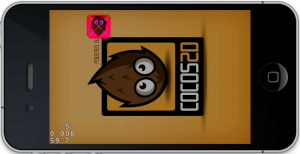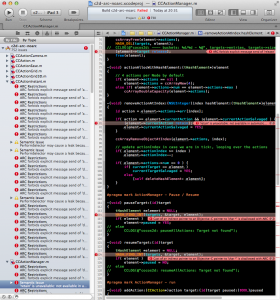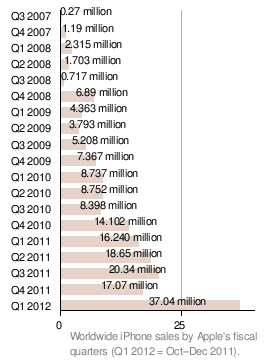 Here’s a crazy thought: with commercial game kits (game source code products) being popular and financially rewarding – why not crowd-fund an iOS game by selling it’s source code, resources and development insights while you’re creating it?
Here’s a crazy thought: with commercial game kits (game source code products) being popular and financially rewarding – why not crowd-fund an iOS game by selling it’s source code, resources and development insights while you’re creating it?
Marcus and I will give this idea a spin. Marcus is a game designer I worked with at Electronic Arts Phenomic for 6 years. I’m sure you know me. Together we’re going to create a tilemap-based physics game using cocos2d and KoboldScript (Lua scripting for cocos2d). And we are going to sell everything we’ll create practically from day one.
If that sounds even slightly intruiging to you, we’d love to get your feedback!
Visit the launch page and take our survey which has already helped us tremendously to focus on what’s important for you. For example I’ve converted the entire KoboldScript library to use ARC seeing how important ARC is to you.
But do keep on reading for more details … Continue reading »

Time to add another project to my github repository. This time I’m answering the frequently asked question (in some form or another) how to zoom in on a particular node. For example zooming in on the player when he dies.
That’s not as trivial as it sounds, but you can make it easy if you follow some guidelines.
First, you want to put all nodes that should be affected by the zoom in the same layer. Then you should avoid changing the position or anchorpoint of the layer - if you still want to change the position of the layer I suggest to add this layer into another, toplevel layer and then only change the position of the toplevel layer. Use the cocos2d node hierarchy to your advantage. And don’t use the CCCamera.
The behavior of this example project is best observed with your own eyes. You can get the ZoomInOnMe project on github.
 I frequently see questions like Should I use game engine A or game engine B? Sometimes the question is slightly more specific like Is game engine A right for this game?
I frequently see questions like Should I use game engine A or game engine B? Sometimes the question is slightly more specific like Is game engine A right for this game?
These questions are not unlike giving a list of features or requirements and then asking Is potential partner A better for me than potential partner B? And some are closer to asking the general public a very subjective question that requires intimate knowledge about the person who is asking: With whom will I have better sex, A or B?
Well … while there’s a checklist of features that A and B may or may not have that might have some influence on the decision, more often than not your choice depends a whole lot more on whether it just feels right.
You may feel attracted to A because A is so reasonable and the support is responsive and helpful, or you may simply find yourself attracted to how B is open to everything and free of charge. You may also find that despite A or B lacking a specific feature you crave, other aspects that you didn’t even think of more than make up for it. Features aren’t everything, more important is the spirit and ease of use.
Not uncommonly a fully featured game engine (or partner) with all bells and whistles may turn out to have a really steep learning curve, many restrictions, limitations, policies, quirks while “free” may cost you a lot more than you bargained for.
Following is my game engine dating advice that you can take to places like MobileGameEngines.com to make your pick. These are the things that I consider the most important when choosing a game engine for small projects, and that is irregardless of the type of game I might want to develop.
 While Cocos2D is compatible with ARC, simply enabling ARC in the project’s Build Setting will throw several hundreds of errors in your face. Cocos2D doesn’t provide ARC-enabled project templates. Thus this tutorial about how to enable ARC in a newly created Cocos2D Xcode Project.
While Cocos2D is compatible with ARC, simply enabling ARC in the project’s Build Setting will throw several hundreds of errors in your face. Cocos2D doesn’t provide ARC-enabled project templates. Thus this tutorial about how to enable ARC in a newly created Cocos2D Xcode Project.
While none of these steps are overly difficult, you’ll notice there’s plenty of steps to perform. Unavoidably, and on the off chance you don’t already know, I’d like to recommend Kobold2D to you if you want to write ARC enabled Cocos2D apps. Because none of the steps below, really zero, zilch, nada, niente, keine are necessary to enable ARC in Kobold2D. That’s because it ships with 15 template projects all of which have ARC enabled out of the box. And Kobold2D 2.0 with cocos2d-iphone 2.0 is just around the corner.
Self-advertisment aside, these steps are tested with cocos2d-iphone v2.0 but should also work with cocos2d-iphone v1.1 - but admittedly I haven’t tested the process with the v1.1 version. If you find anything that’s not quite working with v1.1 please leave a comment. Preferably with the solution, that’ll be awesome!
UPDATE: I released a video version of this tutorial: Continue reading »
With Apple’s blazing Q1 2012 quarterly results, which sees iPhone sales double (!) that of the previous Q4 2011 and last year’s Q1 quarter, it’s time to update my iOS Device sales statistics from July 2011.
Apple’s Quarterly Results Reports have one big flaw for those interested in per-device numbers: Apple only mentions how many iPhones, iPods and iPads they have sold in each quarter, but this includes all models. So you have to exclude the discontinued models as well as somehow determine (if only by guesstimating) how many iPod touch vs regular iPods, or how many iPhone 3G vs iPhone 3GS have been sold in that quarter.
I took the publicly available numbers and then used a reasonable guesstimate to split the device sales of two combined models in order to get a reasonably accurate estimate. I mainly wanted to determine how the gap is widening between the OpenGL ES 1.1 and OpenGL ES 2.0 models. This is particularly interesting for Cocos2D developers who may be wondering if it’s save to upgrade to Cocos2D 2.x or whether it’s still worthwhile to stick with Cocos2D v1.x to be able to deploy even to 1st and 2nd generation iOS devices. Continue reading »
 So you have this website going or some source code on github, and like to earn a few bucks. Donations, right? Hold on, there are a couple things you should consider before you add that Donate button!
So you have this website going or some source code on github, and like to earn a few bucks. Donations, right? Hold on, there are a couple things you should consider before you add that Donate button!
UPDATE: If you prefer a concise, to the point summary of this post, you should read the follow-up post The 10 Golden Rules for a Donate Button.
In case you haven’t noticed, you won’t find a Donate button here or on my other websites. It may seem strange that the guy who never had a donation button of all people should write a guide to the donation button.
I consciously decided against having a donation button. You’ll find a number of reasons in this post, and maybe at the end of it you come to agree with me that Donate buttons are over-used, and the more developers offer them the fewer donations reach those developers who actually need and/or deserve donations the most.
I also wrote this as guidance particularly for individual indie or open source developers who are accepting donations or considering to do so, because donating to an individual is fundamentally different than donating to a (charitable) organisation or a software project (team) as a whole. You will also get some ideas on how you can improve your donation acceptance rate and which alternatives for voluntary compensation and appreciation exist.
Rule Number 1: Be a charity or a business. Never both!
I sell commercial products, both my own and third party products for which I receive a commission fee for each sale. I am self-employed, I make my living from those products and a few select contract jobs for people I know personally. It is fair to say that I’m running a business.
For me the question of whether I should ask for donations boils down to this: should a business be asking for and accepting donations? Continue reading »
I updated the Cocos2D Webcam Viewer project from a previous article to download a file from the web asynchronously, and then load its texture asynchronously as well. You can now switch between the two modes to see how asynchronous operations almost completely removed the pauses the app experiences in synchronous mode. Just tap the screen to switch modes.
Continue reading » To visualize the lag I added a constantly moving sprite at the bottom. This makes the lag easier to spot than a framerate counter. I also removed all error checking code from this article to make the code easier to read. As always you can find the Cocos2D Webcam Viewer source code with full error checking on the LearnCocos2D github repository.
To visualize the lag I added a constantly moving sprite at the bottom. This makes the lag easier to spot than a framerate counter. I also removed all error checking code from this article to make the code easier to read. As always you can find the Cocos2D Webcam Viewer source code with full error checking on the LearnCocos2D github repository.
Wouldn’t it be awesome if you could update your game’s assets while your app is running? It turns out you can, and it’s not even very complicated.
Whether you want to tweak a game setting or experiment with a variety of image styles on the fly, this will be one of the things you wish you had been using all along! Either for faster development or as a design feature for your game.
 In this case, we’ll build a New York Traffic Webcam viewer with Cocos2D. You will learn how to download files to your app at runtime with the iOS SDK and cocos2d-iphone, and how to check if the file on the web server has actually been modified.
In this case, we’ll build a New York Traffic Webcam viewer with Cocos2D. You will learn how to download files to your app at runtime with the iOS SDK and cocos2d-iphone, and how to check if the file on the web server has actually been modified.
Along the way you’ll understand how to use the Mac OS X built-in web server to speed up your development by replacing game assets on the fly. By copying files to a specific directory on your Mac you can make immediate changes to your running app!
And you don’t need any experience with HTML, Apache, or any other web server or web services technology. In fact, I consider myself to be an web-illiterate because I’ve hardly done anything programming-related with web services and servers in the past.
As usual, the project is available from my LearnCocos2D github repository under the MIT License. The project’s name is Cocos2D-UpdateFilesFromWebServer. To improve readability of the article I removed error checking from the code in the article.












